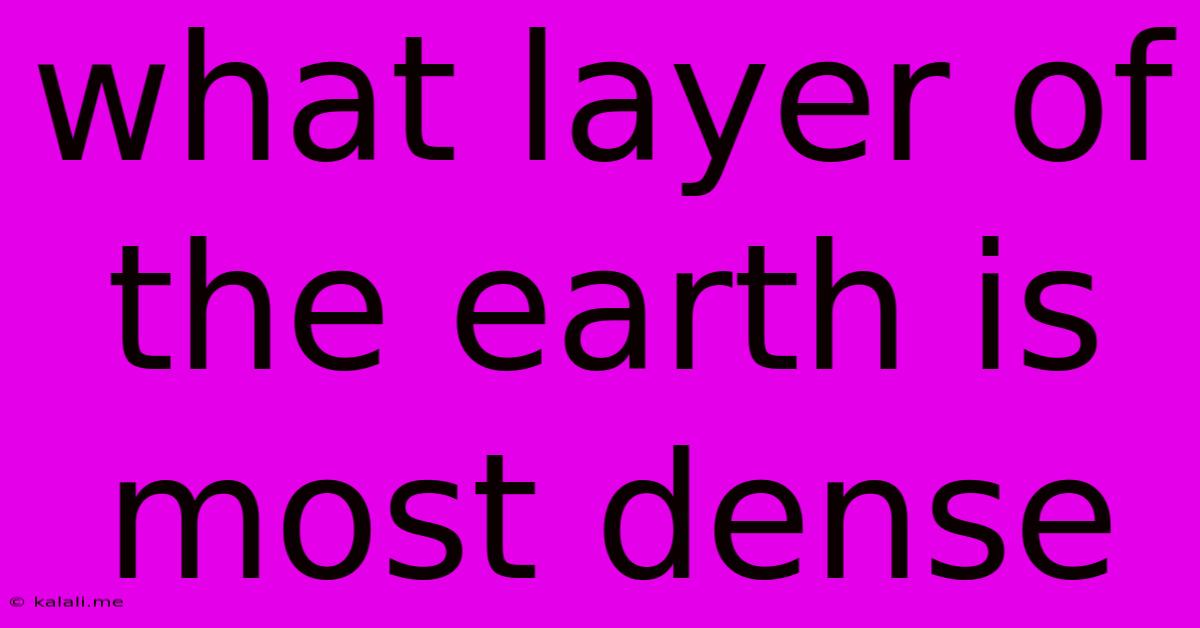What Layer Of The Earth Is Most Dense
Kalali
May 09, 2025 · 3 min read

Table of Contents
What Layer of the Earth is Most Dense? A Deep Dive into Planetary Structure
The Earth, our vibrant and dynamic planet, is far more complex than it appears on the surface. Beneath our feet lies a layered structure, each layer possessing unique characteristics, including density. Understanding these layers is crucial to comprehending geological processes like plate tectonics, volcanic activity, and the planet's magnetic field. So, which layer of the Earth is the most dense? The answer might surprise you. This article delves into the Earth's internal structure to unveil the truth.
The Earth's density isn't uniform; it varies significantly with depth. This variation is primarily due to differences in composition and pressure. The Earth's internal layers are broadly classified into four main regions: the crust, mantle, outer core, and inner core.
The Crust: A Relatively Thin Shell
The crust is the outermost layer, forming the Earth's solid surface. It's relatively thin, ranging from about 5 km under the oceans (oceanic crust) to 70 km under continents (continental crust). The crust is primarily composed of silicate rocks, with a density that's relatively low compared to the deeper layers.
The Mantle: A Largely Solid Rocky Layer
Below the crust lies the mantle, a much thicker layer extending to a depth of about 2,900 km. The mantle is primarily composed of silicate rocks rich in iron and magnesium. While primarily solid, the mantle exhibits ductile behavior, meaning it can flow slowly over geological timescales. The pressure within the mantle significantly increases with depth, leading to a gradual increase in density.
The Outer Core: A Liquid Sea of Iron and Nickel
At a depth of around 2,900 km, we reach the outer core. This layer is approximately 2,200 km thick and is composed primarily of liquid iron and nickel. The immense pressure and temperature in the outer core contribute to its fluidity. The density of the outer core is significantly higher than the mantle due to the presence of heavy metals and the compression from overlying layers. The movement of this liquid iron generates the Earth's magnetic field – a vital protective shield against harmful solar radiation.
The Inner Core: A Solid Iron-Nickel Sphere Under Immense Pressure
At the Earth's center, about 5,150 km below the surface, lies the inner core. This is a solid sphere with a radius of approximately 1,220 km. It's composed primarily of iron and nickel, just like the outer core, but its density is even greater. The extreme pressure at the center of the Earth forces the iron and nickel atoms to pack incredibly tightly, resulting in the inner core's solid state despite the incredibly high temperature. This intense pressure is the key to understanding its incredibly high density.
The Verdict: The Densest Layer
Considering the composition and the effects of pressure, the inner core is the densest layer of the Earth. The immense pressure compresses the iron and nickel atoms to a degree that far exceeds the density achievable in any other layer. While the outer core contains the same basic materials, the lack of the same immense pressure prevents it from reaching the inner core's extreme density.
Understanding the density variations within the Earth provides invaluable insights into the planet's formation, evolution, and ongoing geological processes. Further research continues to refine our understanding of this complex and fascinating system. The mysteries of the deep Earth are still being uncovered, constantly challenging our knowledge and pushing the boundaries of scientific exploration.
Latest Posts
Latest Posts
-
Which Quadrilaterals Always Have Diagonals That Bisect Opposite Angles
May 09, 2025
-
Cuanto Es 28 Grados Centigrados En Fahrenheit
May 09, 2025
-
What Is The Decimal For 1 10
May 09, 2025
-
The Division Of Cytoplasm Is Called
May 09, 2025
-
How Many Inches In 6 Feet Tall
May 09, 2025
Related Post
Thank you for visiting our website which covers about What Layer Of The Earth Is Most Dense . We hope the information provided has been useful to you. Feel free to contact us if you have any questions or need further assistance. See you next time and don't miss to bookmark.